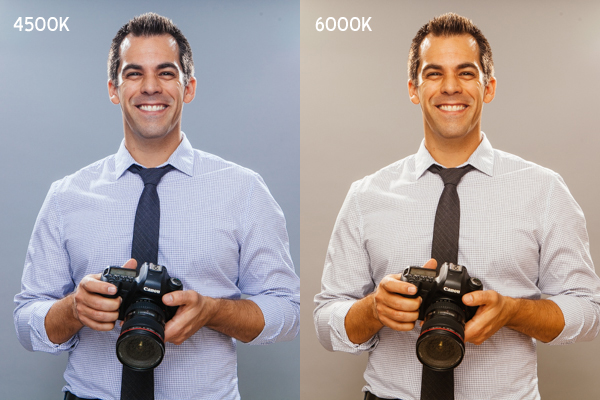Understanding color temperature is an important part of becoming a serious photographer. As an amateur, most of the time you can leave your camera on the auto-white balance setting and get a pretty good result. But, as you get into more complex situations or scenes with multiple light sources, having an understanding of the effect of color temperature will help you to have more control over your results. The color of light is fairly simple in theory and more complicated in practice.
Let’s breakdown the fundamentals of color temperature to help elevate your photography skills from novice to pro.

Range of color temperature
The visible spectrum of light color is measured in Kelvin (K) and goes from a low Kelvin value of red (about 1000 K) to a high Kelvin value of blue (15,000+ K). For the purpose of this post we are only going to talk about the lights that you would encounter in normal photography, which range from about 2500 K to 10,000 K. For reference, 2500K would look like a regular household incandescent bulb and would make objects appear to have an orange cast.
Halogen bulbs would be slightly more yellow at 3200K. Fluorescent bulb are rated around 4700K. Daylight, also considered to be the most neutral light (neither warm nor cool) at 5500K appears to be even, without an orange or blue cast. The color of light starts turning blue in the shade as you move up toward 8000K, and further to 12,000K in the clear blue sky. Flash units are generally manufactured to be daylight balanced and emit a neutral colored light.
Adjusting in camera or in RAW
Because our eyes and brain can do some adjusting to color temperature, we need our cameras to do the same in order to make things look like they do to our eyes. If we leave our cameras on daylight balance (5500K) then indoor photos will look too orange. If we leave them on tungsten balance (3500K) then outdoor photos will look too blue.
Nowadays, auto white balance does a pretty good job of figuring it out for you, but nothing beats experience and dialing in the exact color temperature you need in camera. If you shoot in RAW, you are able to adjust the color temperature in post-processing, which is very helpful to get the color perfectly accurate.

The author at two different color temperature settings
Fluorescent
Fluorescent lighting is interesting because, although it turns up pretty close to neutral on the Kelvin scale, it doesn’t look that way to our cameras. The Kelvin scale only measures the color as it moves from red/orange to blue. Fluorescent lights have a greenish cast to them, which cannot be accounted for in the color balance settings. For this you would adjust the tint, which controls the balance of green and magenta — opposites on the color wheel.
Mixed lighting
In photography, the big issue we run into, and the whole reason to really understand color temperature, is mixed lighting. If your ambient light is coming from an orange-colored incandescent bulb (2500K) and you want to use your daylight balanced (5500K) flash, it will be very clear in a color photograph that there are different colors of light.
This can be jarring for a viewer. Similarly, if you want to use a warm colored halogen light (3200K) on a shady set (7000K), your subject and background will be at very unnaturally different color temperatures.
Using gels to compensate
Short of changing light bulbs to get around color temperature differences, we use gels to change the color of the light coming from our light sources. Placing an orange gel over your daylight-balanced flash will help it to blend in with any existing incandescent lights. Placing a green gel on your flash will match the color coming from fluorescent bulbs. Conversely, placing a magenta gel on your fluorescent bulb can work to neutralize the color and turn the green cast into white. Knowing the color ratings for the lights you are working with will help you to choose the right gels.

Share tips, start a discussion or ask one of our experts or other students a question.
No Responses to “The Color of Light: Basics of Color Temperature”